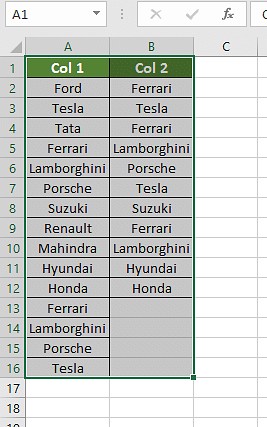Comparing two columns for duplicates in Excel is a common task in data analysis. Doing this manually can be time-consuming and error-prone, especially with large datasets. Fortunately, Excel provides several efficient methods to identify duplicates quickly and accurately. This article will guide you through various techniques, from basic comparisons to more advanced formulas, empowering you to effectively analyze your data.
Methods for Comparing Two Columns in Excel
Several methods exist for comparing two columns in Excel to find duplicates:
1. Conditional Formatting
Conditional formatting allows you to visually highlight duplicate values. Select the two columns, navigate to the “Home” tab, click “Conditional Formatting,” and choose “Highlight Cells Rules.” Then, select “Duplicate Values.” Excel will highlight all duplicate entries across both columns.
2. Using the Equals Operator (=)
A simple formula using the equals operator can identify matching values. In a new column, enter the formula =A1=B1 (assuming your data is in columns A and B). This will return TRUE for matches and FALSE for non-matches. You can enhance this with the IF function: =IF(A1=B1,"Match","No Match") for clearer results.
3. Leveraging the VLOOKUP Function
VLOOKUP can be used to check if a value in one column exists in another. The formula =VLOOKUP(A1,B:B,1,FALSE) searches for the value in cell A1 within column B. If found, it returns the value; otherwise, it returns #N/A. Using =IFERROR(VLOOKUP(A1,B:B,1,FALSE),"No Match") replaces errors with a clear message. Wildcards (* or ?) can be incorporated within VLOOKUP for partial matches.
4. Employing the EXACT Function
The EXACT function performs a case-sensitive comparison. =EXACT(A1,B1) returns TRUE only if the values in A1 and B1 are identical, including case. This is useful when even minor case differences are significant.
5. Utilizing the IF Formula with Specific Conditions
The IF formula can be combined with other functions for more complex comparisons. For example, =IF(AND(A2=B2,A2=C2),"Complete Match","") checks for matches across three columns.
Choosing the Right Method
The optimal method depends on your specific needs:
- Visual identification: Conditional formatting is best for quickly highlighting duplicates.
- Simple matching: The equals operator is sufficient for basic comparisons.
- Cross-referencing: VLOOKUP is ideal for finding values from one list in another.
- Case-sensitive matching: The EXACT function is crucial when case sensitivity matters.
- Multiple column comparison: Combining IF with AND or other functions addresses more complex scenarios.
Conclusion
Excel provides a versatile toolkit for comparing two columns and identifying duplicates. By understanding these methods, you can choose the most effective technique for your data analysis needs, saving time and improving accuracy. Mastering these techniques will enhance your data analysis capabilities and allow you to extract valuable insights from your spreadsheets.

